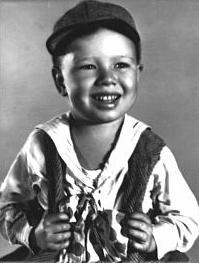SPANKY & OUR GANG
Only us vintage people would remember. SPANKY & OUR GANG
"Something I bet a lot of you didn't know, I certainly didn't!"
These pictures are great.
"Something I bet a lot of you didn't know, I certainly didn't!"
These pictures are great.
What ever happened to those people?
In case you forgot who is who.
Well, here it is...
"The Our Gang Curse"
....................................................
Alfalfa --
Carl Switzer was shot to death at age 31.
Chubby --
300-pound Norman Chaney died at age 22 following an operation.
Buckwheat --
William Thomas died at age 49 of a heart attack.
(wow I never knew that buckwheat was a man!!)
Darla Hood --
The Our Gang leading lady contracted hepatitis and died at age 47.
Brisbane --
Kendall McCormas, known as Breezy Brisbane,
committed suicide
at age 64.
at age 64.
Froggy --
William Robert Laughline was killed in a motor scooter accident at age 16.
Mickey Daniels
He died of liver disease at 55.
Stymie --
Mathew Bear led a life of crime and drugs. He died of a stroke at age 56.
Scotty Beckett --
He died at age 38 following a brutal beating.
Wheezer --
Robert Hutchins was killed in an airplane accident at age 19.
Pete the Pup --
He was poisoned by an unknown assailant.
Butch --
Currently lives in California
And Spanky....
Robert Blake was accused of murdering his wife.
I did not know that was Robert Blake!
Did any of you? Wow!
Did any of you? Wow!
I am sure all your 'elder' friends, will love this!
.........................................................................................................................
Here's to all of us born before 1979!
First, we survived being born to mothers who smoked and/or drank while they were pregnant. They took aspirin, ate blue cheese dressing, tuna from a can and didn't get tested for diabetes.Then after that trauma, we were put to sleep on our tummies in baby cribs covered with bright colored lead-base paints.
We had no childproof lids on medicine bottles, locks on doors or cabinets and when we rode our bikes, we had baseball caps not helmets on our heads.
As infants & children, we would ride in cars with no car seats, no booster seats, no seat belts, no air bags, bald tires and sometimes no brakes. Riding in the back of a pick- up truck on a warm day was always a special treat.
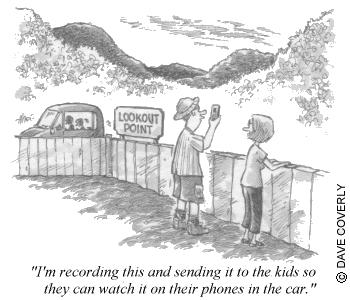 We drank water from the garden hose and not from a bottle. We shared one soft drink with four friends, from one bottle and no one actually died from this.
We drank water from the garden hose and not from a bottle. We shared one soft drink with four friends, from one bottle and no one actually died from this.We ate cupcakes, white bread, real butter and bacon. We drank Kool-Aid made with real white sugar. And, we weren't overweight.. WHY?
Because we were always outside playing...that's why! We would leave home in the morning and play all day, as long as we were back when the streetlights came on.. No one was able to reach us all day. And, we were OKAY.
We would spend hours building our go-carts out of scraps and then ride them down the hill, only to find out we forgot the brakes. After running into the bushes a few times, we learned to solve the problem.
We did not have Play Stations, Nintendo's and X-boxes. There were no video games, no 150 channels on cable, no video movies or DVD's, no surround-sound or CD's, no cell phones, no personal computers, no Internet and no chat rooms.
WE HAD FRIENDS and we went outside and found them!
We fell out of trees, got cut, broke bones and teeth and there were no lawsuits from these accidents.
We would get spankings with wooden spoons, switches, ping pong paddles, or just a bare hand and no one would call child services to report abuse.
We ate worm and mud pies made from dirt, and the worms did not live in us forever.
We were given BB guns for our 10th birthdays, made up games with sticks and tennis balls and, although we were told it would happen, we did not poke out very many eyes.
We rode bikes or walked to a friend's house and knocked on the door or rang the bell, or just walked in and talked to them.
Little League had tryouts and not everyone made the team. Those who didn't had to learn to deal with disappointment. Imagine that!
The idea of a parent bailing us out if we broke the law was unheard of. They actually sided with the law!
These generations have produced some of the best risk-takers, problem solvers and inventors ever. The past 50 years have been an explosion of innovation and new ideas.
We had freedom, failure, success and responsibility, and we learned how to deal with it all.
If YOU are one of them, CONGRATULATIONS!
You might want to share this with others who have had the luck to grow up as kids, before the lawyers and the government regulated so much of our lives for our own good. Kind of makes you want to run through the house with scissors, doesn't it?
LIMBO DANCE
In Trinidad, the Limbo was a part of a funeral dance. Mourners at the funeral would walk towards a horizontal bamboo pole and would attempt to walk forward, while bending backwards at the waist in order to move under the pole without knocking it off of its supports. The act was meant to symbolize the passage that the soul of the departed would take between life and the afterlife. Being able to pass under the bar without disturbing the pole or falling down was difficult symbolizing the difficulty of the journey to heaven and thus that difficult period of time was spent in limbo (the area between heaven and hell. As the clapping and chanting mourners followed each other under the pole, the pole was moved lower and lower towards the ground.
Eventually, it was showcased in the 1960 movie "Where the Boys Are." For the next year and a half it spread like wildfire across the country, but began to fade in 1962. In 1963, however, Chubby Checker, the man who made the Twist famous released a song called "limbo Rock" which quickly soared to number one on the charts and finished the year as the top song of the year. In the song, Checker asked "how low can you go." In Canada, a 15 year old girl was able to go as low as 6 1/8 inches from the ground. As with most fads, the limbo craze finally petered out when the public became infatuated with the arrival of the Beatles.
American tourists in the 1950's witnessed the event and demonstrated it for friends at home. Boscoe Holder, a dancer from Trinidad was one of the most famous limbo artists and used it in his dance routine. As more people were exposed to it, the limbo craze took off, first among teenagers and beatniks, then among their parents at dinner parties.
“KILROY WAS HERE”
The phrase was scrawled on desolate beachheads, notable landmarks and on walls everywhere. The message was believed to have been left by an American, although it was often discovered by the first American troops to enter areas formerly occupied by enemy troops. The phrase irritated German and Japanese troops to no end but delighted (and also bewildered) American forces as it added much needed levity to the brutality of war. It also provided a great deal of mystery about who Kilroy was and how he got to so many areas of the war before anyone else.
Kilroy was here! The message appeared mysteriously all over Europe and the Pacific during World War II.
THE TWIST

It all started in 1961 at a little club called The Peppermint Lounge in New York City. Stars like Judy Garland, Greta Garbo and even the Duke and Duchess of Windsor were introduced to the a new dance called the Twist.
Although originally popular only with young black Americans, Chubby Checker helped the dance to break into the mainstream when he appeared on American Bandstand with Dick Clark.
Not only was the Twist a hit with the music industry, but it could also be seen in a number of films. In the early sixties, movies such as Twist Around the Clock, Viva La Twist and Teenage Millionaire continued the new craze of Twisting.
Want to try the dance? Pretend like you are stepping out of the bath and towel off your back, or pretend you are putting out a cigarette with your toe. Put some Chubby Checker on and you've mastered the Twist.
The dance slowly started to fade when other dances - such as the Mashed Potato and Watusi hit the scene in 1962 but its popularity often returns because of movies and television shows.

It all started in 1961 at a little club called The Peppermint Lounge in New York City. Stars like Judy Garland, Greta Garbo and even the Duke and Duchess of Windsor were introduced to the a new dance called the Twist.
Although originally popular only with young black Americans, Chubby Checker helped the dance to break into the mainstream when he appeared on American Bandstand with Dick Clark.
Not only was the Twist a hit with the music industry, but it could also be seen in a number of films. In the early sixties, movies such as Twist Around the Clock, Viva La Twist and Teenage Millionaire continued the new craze of Twisting.
Want to try the dance? Pretend like you are stepping out of the bath and towel off your back, or pretend you are putting out a cigarette with your toe. Put some Chubby Checker on and you've mastered the Twist.
The dance slowly started to fade when other dances - such as the Mashed Potato and Watusi hit the scene in 1962 but its popularity often returns because of movies and television shows.
BELL BOTTOM PANTS
Derived from the style of Naval uniforms, bellbottoms became the fashion statement of the bohemian sector of young society in the late 1960's. They also became a prominent symbol of the wildly stylish 1970's.
Bellbottoms were initially designed for Naval personnel. They were designed to flare out at the bottom so that sailors could quickly remove their boots in an emergency situation. The pants became popular as musicians like James Brown, Sonny and Cher and Elvis Presley enjoyed their bell like form. When hippies saw the bell-shaped pants leg, they seemed like a counter-culture alternative to the straight-legged, straight-laced adult-oriented clothing worn by their parents.
Made of denim, the popularity of the pants was enormous, however, they were unavailable in many parts of the country where they were seen as too much of a fashion statement. Some enterprising youths decided to create their own bellbottoms by splitting their jeans along the seams and sewing in a triangular panel.
While the original popularity of the pants focused on denim fabrics, eventually designs emerged, some made of polyester and others of corduroy. These versions were more conservative, with a much smaller bell at the bottom. These so-called "flares" were much like recent "boot cut" pants and were worn by hippies and non-hippies alike.
Bellbottoms were a cultural statement of the youth-oriented hippie generation. They made a big come in the mid-1990's as the Generation X crowd unknowingly followed in their parents footsteps.
COONSKIN CAP
The coonskin cap was made popular in late 1954 with the debut of Fess Parker in the role of Walt Disney's "Davy Crockett, Indian Fighter."
The popular coonskin cap headgear worn by Parker in the movie became the most popular item among the Davy Crockett products which pulled in $100 million.
The caps were most popular with young boys but many adults joined in on the craze, wearing them at numerous public appearances.
After a shortage in raccoon tails caused people to turn to using muskrat, rabbit, and fox tails, the fad died out by December of 1955.
THE YO-YO
Made of denim, the popularity of the pants was enormous, however, they were unavailable in many parts of the country where they were seen as too much of a fashion statement. Some enterprising youths decided to create their own bellbottoms by splitting their jeans along the seams and sewing in a triangular panel.
While the original popularity of the pants focused on denim fabrics, eventually designs emerged, some made of polyester and others of corduroy. These versions were more conservative, with a much smaller bell at the bottom. These so-called "flares" were much like recent "boot cut" pants and were worn by hippies and non-hippies alike.
Bellbottoms were a cultural statement of the youth-oriented hippie generation. They made a big come in the mid-1990's as the Generation X crowd unknowingly followed in their parents footsteps.
COONSKIN CAP
The coonskin cap was made popular in late 1954 with the debut of Fess Parker in the role of Walt Disney's "Davy Crockett, Indian Fighter."
The popular coonskin cap headgear worn by Parker in the movie became the most popular item among the Davy Crockett products which pulled in $100 million.
The caps were most popular with young boys but many adults joined in on the craze, wearing them at numerous public appearances.
After a shortage in raccoon tails caused people to turn to using muskrat, rabbit, and fox tails, the fad died out by December of 1955.
THE YO-YO
Pedro Flores who began manufacturing an improved version of the yo-yo in the late 1920's used a slip string which accommodated the up and down movement as well as permitting the toy to "spin" suspended at the end of the string (often referred to as "sleeping" or "sticking."
In 1929, Donald F. Duncan purchased the rights to the toy from Flores and set out to market the yo-yo as America's favourite toy. Duncan was certainly no stranger to successful marketing a product. Duncan was the inventor of the Eskimo Pie ice cream, the founder of the Good Humour Ice Cream franchise, creator of the parking meter among other things. Duncan imported a number of teenagers from the Philippines to demonstrate the toy and numerous tricks and stunts to the American public. His marketing worked and quickly his toy (which he called the "O-Boy Yo-yo Top") was a bestseller. It sold three million units in Philadelphia alone during a month in 1931.
Unfortunately, World War II emerged and a national rationing effort made material for the toy scarce. After the war, Duncan faced a number of competitors and saw his market share dwindle. In the early 1960's, however, Duncan's fortune seemed to change. Along with the standard version (which was called the "Imperial") Duncan introduced another version called the Butterfly and in 1962, 45 million units were sold followed by 56 million more in 1963.
Unfortunately, World War II emerged and a national rationing effort made material for the toy scarce. After the war, Duncan faced a number of competitors and saw his market share dwindle. In the early 1960's, however, Duncan's fortune seemed to change. Along with the standard version (which was called the "Imperial") Duncan introduced another version called the Butterfly and in 1962, 45 million units were sold followed by 56 million more in 1963.
Teddy Bears
Perhaps the longest lived and most popular fad ever, the Teddy Bear has become a fixture in the life of almost every child in the United States. In the early part of the 20th century, it was probably the most important object in a child's nursery.
The Teddy Bear doll was developed in response to the popularity of the story of an encounter between a small bear cub and Teddy Roosevelt.
Quickly, Teddy Bear mania swept the country as they ended up not only in every child's room, but also appeared in newspaper and magazine adventure stories and children's books. They also appeared on plates, blankets, hats and other household items. Eventually, however, the mania began to fade when Roosevelt decided not to seek re-election. While the mania did not last, America's love affair with the bear dolls certainly did.
THE SLINKY
The Slinky™ originated from James' experience as a shipbuilder when a coil spring he was working with fell off of a shelf and began to gyrate and make slithering movements as it moved across the floor. The spring appealed to his curiosity and he devised a plan to create a toy out of it. He got a chance to try the toy out on a bedridden boy. After the boy was delighted, James set forth producing and marketing the toy. He went from store to store and was rejected by all of them until he found a small shop that agreed to take on four dozen units on consignment. Before James got home, the toys had sold out and the shopkeeper begged for several more. James and his wife set out producing and selling the Slinky™ full-time and over the Christmas season, the toy was a major hit and they had difficulty meeting the overwhelming demand for it.
The Slinky™ was made of an 87 foot piece of wire, three inches in diameter and two inches high when flattened. It could, however, be mad to perform numerous tricks, the most famous of which was being turned end over end, seemingly walking down stairs.
James battled through patent litigation disputes, steel shortages, warehouse fires and problems with local Philadelphia inspection officials to sell an estimated 14 million units in a ten year period - and the Slinky™ continues to be a best seller even today.
RAGGEDY ANN & RAGGEDY ANDY
Gruelle was a friend of noted poet James Whitcomb Riley, the creator of Little Orphan Annie. With that in mind, he named the rag doll Raggedy Ann. He used the doll as a model for a cartoon he drew for the New York "World" and then wrote a book called "Raggedy Ann Stories." The growing popularity if the character drove him to create a companion which he named Raggedy Andy. The dolls both had shoe-buttons for eyes, red yarn for hair, and striped socks. Ann wore a print dress and Andy a checked shirt with blue slacks. Both also had a heart, upon which was written the words "I Love You."
Johnny Gruelle was a political cartoonist in New York with a young daughter. While looking around his attic, he stumbled upon an old rag doll, which after years of wear and tear, had faded in appearance. Gruelle decided to hand-draw a new face on the doll and gave it to the little girl.
Over the next twenty years, more than ten million copies of Raggedy Ann and Andy books were sold. Gruelle died in 1938 but his work has continued to be an important part in the lives of millions of children around the world.
OP-YOP
Made of two plastic, multi-coloured discs with a string running through and between them. When the string was pulled together, the discs moved apart and then clapped together with a loud noise.
Manufactured by Kramer Designs, more than two million units of the toy sold before they faded into fad oblivion
For a period of 1968, the Op-Yop was the favourite toy across the country.
Manufactured by Kramer Designs, more than two million units of the toy sold before they faded into fad oblivion
For a period of 1968, the Op-Yop was the favourite toy across the country.
OUIJA BOARD
MATCHBOX CARS
They were called Matchbox cars because they were small enough to be carried around in a match box. The cars were known for their quality of detail and craftsmanship. The first Matchbox cars were made in 1953 and each year new cars were added, with some being replaced, until there were 75 cars (there were never more than models in each year's line). The first four models were the Muir Hill Site Dumper, the Road Roller, the Massey Harris Tractor and the Cement Mixer. The cars were originally distributed by the Moko company and in 1956 Lesney started making the "Models of Yesteryear." These were detailed cars of the past and came in the yellow Matchboxes.
KEWPIE DOLL
One of the most popular and long lived fad items of all time, the Kewpie Doll had its roots in the Ladies' Home Journal magazine, where an author, Rose O'Neil, wrote children's poems and used illustrations of characters which would become Kewpies. The year was 1909, and the cartoon drawings would quickly evolve into paper doll versions and then into unglazed ceramic items which would cause them to soar in popularity. Soon an overwhelming demand would call for the production of kewpie inkwells, saltshakers, perfume bottles, earrings, bracelets and pipe tobacco accessories. Kewpie Dolls (which were named in honour of Cupid) were big cheeked, wide-eyed, round tummied little creatures which immediately appealed to children. Initially Ms. O'Neil developed a series of the dolls, each with their own names and personalities and four years after their creation, more than five million had been sold. With the coming of World War I, Ms. O'Neil stopped writing stories about Kewpies but brought them back in 1925. In 1930, the dolls regained popularity, not as the cute national treasure they had been but instead as giveaways at carnivals and festivals.
One of the most popular and long lived fad items of all time, the Kewpie Doll had its roots in the Ladies' Home Journal magazine, where an author, Rose O'Neil, wrote children's poems and used illustrations of characters which would become Kewpies. The year was 1909, and the cartoon drawings would quickly evolve into paper doll versions and then into unglazed ceramic items which would cause them to soar in popularity. Soon an overwhelming demand would call for the production of kewpie inkwells, saltshakers, perfume bottles, earrings, bracelets and pipe tobacco accessories. Kewpie Dolls (which were named in honour of Cupid) were big cheeked, wide-eyed, round tummied little creatures which immediately appealed to children. Initially Ms. O'Neil developed a series of the dolls, each with their own names and personalities and four years after their creation, more than five million had been sold. With the coming of World War I, Ms. O'Neil stopped writing stories about Kewpies but brought them back in 1925. In 1930, the dolls regained popularity, not as the cute national treasure they had been but instead as giveaways at carnivals and festivals.
Cat's Cradle
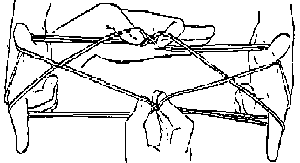
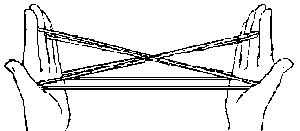
Cat's Cradle
AsiaA: FMRL pu SN mt-gr nHS pu-tw ar H
M pu PS to create The Cradle
Person A: Pick up the string noose on your forefingers, middle, ring, and little fingers so the string goes between thumbs and forefingers and around the back of your hands. Turn palms towards you and grab the near hand string with your forefingers, middle, ring, and little fingers. Turn palms away from you and pick up the near string onto your forefingers, middle, ring, and little fingers. There are now two strings across the back of your hands and one across the palms. Right middle finger now picks up the left palm string, then left middle finger goes between right middle finger noose and picks up the right palm string similar to Opening A. This is The Cradle. You can make it look more like the cat's cradle by temporarily inverting your hands with fingers pointing down.

Soldier's Bed
B: TF gr 2XSPerson B: With thumbs and forefingers, move from above and grab the two crossed strings, pulling them out away from the center of the figure.
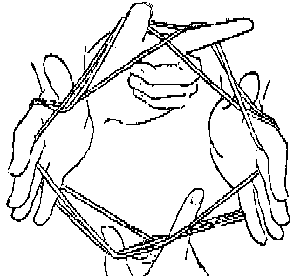
B: TF pu n&fSS
Person B: Move thumbs and forefingers under the near and far straight strings on Person A's hands and pick them up.
Note: Soldier's Bed also known as Chess Board (Korea), Church Window (England), A Mountian Cat (Japan), and A Pond (parts of USA)
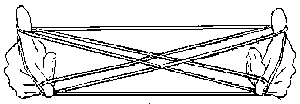
B: re S from A's H
Person B: Extend thumb and forefingers up, removing the strings from Person A's hands to make the Soldier's Bed.
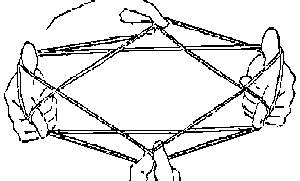
Candles
A: TF md-th TLN gr XSPerson A: With thumbs and forefingers, move down from above into the narrow thumb and little finger nooses and grab the crossed strings, pulling them out away from the center of the figure.
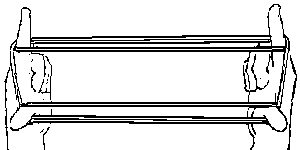
A: TF mu-pu n&fSS
Person A: With thumbs and forefingers, move under and pick up the near and far straight strings to make the Candles. Also known as Chopsticks (Korea), and the Mirror (Denmark).
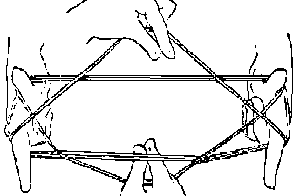
The Manger
B: L mo FS gr fTS, ex:other L gr nFSPerson B: With the little finger on Person A's forefinger side, reach over the forefinger strings and grab Person A's far thumb string, then pull it out over the forefinger strings. With the other little finger grab and pull out the near forefinger string.
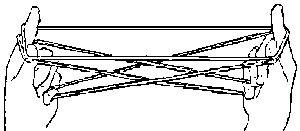
B: TF mu-pu n&fSS
Person B: Move thumbs and forefingers under the near and far straight strings on Person A's hands and pick them up to make The Manger, an inverted Cradle.
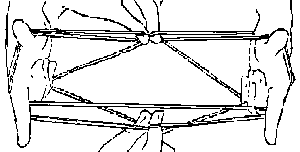
Diamonds
A: TF mu-gr 2XSPerson A: With thumbs and forefingers, move from below and grab the two crossed strings, pulling them out away from the center of the figure.

A: TF mo-pu n&fSS
Person A: Move thumbs and forefingers over the near and far straight strings on Person B's hands and pick them up, removing the strings from Person B's hands to make Diamonds, an upside down Soldier's Bed.
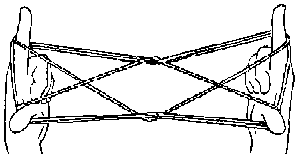
Cat's Eye
B: same steps as CandlesPerson B: Do the same steps as you did to make Candles to make Cat's Eye also known as Cow's Eyeball (Korea), and Horse Eye (Japan).
You, Person A, can go back to The Manger by pulling out the diagonal strings where they cross through the center of the paired near thumb and far forefinger strings, then transfer them to your little fingers and pull them out away from the center of the figure. Next go down and through your little finger nooses and pick up the center straight strings on thumbs and forefingers, removing the strings from Person B's hands.

Fish in a Dish
A: TF mo-gr XS pu DSPerson A: With thumbs and forefingers, move down from above and grab the crossed strings and then pick up the diagonal strings.
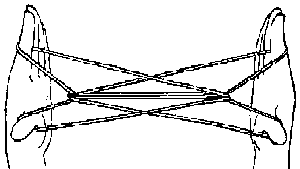
A: re S from B's H, ex TF
Person A: Remove the strings from Person B's hands, and extend thumbs and forefingers apart to make a Fish in a Dish also known as Rice-mill (Korea), and Musical Instrument (Japan)
From here you can do the Clock, which ends the game of Cat's Cradle, or you can go back to an inverted Soldier's Bed that leads to Candles and so on. To go back, Person B grabs the crossed strings from above, then separates the two center strings by forcing their thumbs and forefingers to go down between them, then spreading thumbs and forefingers, and removing the strings from Person A's hands. If Person B comes up from below and through the two center strings, instead of down, the Cat's Eye is formed.
To go back to The Manger, Person B separates the paired center strings and transfers them to their little fingers that then pull them out. Thumbs and forefingers then move down through Person B's little finger nooses and grab the crossed strings from above, thumbs and forefingers then rotate up into the center of the figure removing the strings from Person A's hands.
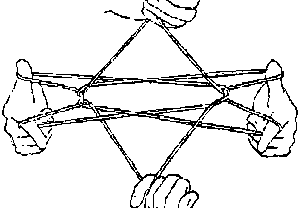
Clock
B: separate cSS:L gr cSS, exPerson B: Grab the crossed strings and pull them out to separate the two center straight strings so they do not cross. With your lilttle fingers grab the separated center straight strings. Pull them out over the crossed strings away from the center of the figure.
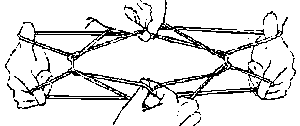
B: L ht, TF gr XS pu DS
Person B: While still holding the string in your little fingers, grab from above the crossed strings, then pick up the diagonal strings with your thumbs and forefingers by rotating them up through the center of the figure.
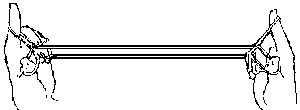
B: re S from A's H
Person B: Extend thumb and forefingers up, removing the strings from Person A's hands to make the Clock. Held vertically this figure represents a tall grandfather type clock (slightly). Do this figure only if you want to end the game.
There are many variations on Cat's Cradle. Try doing something different occasionally. You may come up with a new figure that terminates the game, or you may be surprised to find you have jumped to one of the other figures from which you can continue the game. For example you can go from Soldier's Bed to an inverted Cat's Eye by picking up the crossed strings from below, instead of above, and then picking up the straight strings from above.
FENDER SKIRTS
I haven't thought about fender skirts in years. When I was a kid, I considered it such a funny term. Made me think of a car in a dress. Thinking about fender skirts started me thinking about other words that quietly disappear from our language with hardly a notice.
Like "curb feelers" and "steering or necker knobs". Since I'd been thinking of cars, my mind naturally went that direction first. Any kids will probably have to find some elderly person over 50 to explain some of these terms.
Remember "Continental kits?" They were rear bumper extenders and spare tire covers that were supposed to make any car as cool as a Lincoln Continental.
When did we quit calling them "emergency brakes?" At some point "parking brake" became the proper term. But I miss the hint of drama that went with "emergency brake."
I'm sad, too, that almost all the old folks are gone who would call the accelerator the "foot feed."
Here's a phrase I heard all the time in my youth but never anymore -"store bought." Of course, just about everything is store-bought these days. But once it was bragging material to have a store-bought dress or a store-bought bag of candy.
"Wall-to-wall" was once a magical term in our homes. In the 50's, everyone covered their hardwood floors with, wow, wall-to-wall carpeting! Today, everyone replaces their wall-to-wall carpeting with hardwood floors. Go figure.
When's the last time you heard the quaint phrase "in the family way?" It's hard to imagine that the word "pregnant" was once considered a little too graphic, a little too clinical for use in polite company. So we had all that talk about stork visits and "being in a family way" or simply "expecting".
Apparently "brassiere" is a word no longer in usage. I said it the other day and my daughter cracked up. It's just "bra" now. "Unmentionables" probably wouldn't be understood at all.
It's hard to recall that this word was once said in a whisper - "divorce." And no one is called a "divorcee" anymore. Come to think of it, "confirmed bachelors" and "career girls" are long gone, too.
Most of these words go back to the '50s, but here's a pure-60s word I came across the other day - "rat fink." Ooh, what a nasty put-down!
Here's a word I miss - "percolator." That was just a fun word to say. And what was it replaced with? "Coffeemaker." How dull. Mr. Coffee, I blame you for this.
Food for thought - Was there a telethon that wiped out lumbago? Nobody complains of that anymore. Maybe that's what castor oil cured, because I never hear mothers threatening their kids with castor oil any more.
Some words aren't gone, but are definitely on the endangered list. The one that grieves me most - "supper." Now everybody says "dinner". Save a great word. Invite someone to "supper". Discuss fender skirts.
HAVE A GREAT DAY!
*****************
THIS WAS THE LIFE........DO YOU REMEMBER WHEN.........?
It took five minutes for the TV to warm up?
Nearly everyone's mom was at home when the kids got home from school?
Nobody owned a purebred dog?
When a quarter was a decent allowance?
Your mom wore nylons that came in two pieces?
All your male teachers wore neckties and female teachers had their hair done every day and wore high heels?
You got your windshield cleaned, oil checked, and gas pumped, without asking, all for free, every time? And you didn't pay for air?
Laundry detergent had free glasses, dishes or towels hidden inside the box?
It was considered a great privilege to be taken out to dinner at a real restaurant with your parents?
They threatened to keep kids back a grade if they failed.....and they did?
When a '57 Chevy was everyone's dream car....to cruise, peel out, lay rubber or watch submarine races, and people went steady?
No one ever asked where the car keys were because they were always in the car, in the ignition, and the doors were never locked?
Lying on your back in the grass with your friends and saying things like, "That cloud looks like a..." and playing baseball with no adults to help kids with the rules of the game?
Stuff from the store came without safety caps and hermetic seals because no one had yet tried to poison a perfect stranger?
When being sent to the principal's office was nothing compared to the fate that awaited the student at home? Basically we were in fear for our lives, but it wasn't because of drive-by shootings, drugs, gangs, etc.
Our parents and grandparents were a much bigger threat! But we survived because their love was greater than the threat.
Summers filled with bike rides, baseball games, Hula Hoops, bowling and visits to the swimming hole.
HOW MANY OF THESE DO YOU REMEMBER???
Candy cigarettes
Wax Coke-shaped bottles with colored sugar water inside
Soda pop machines that dispensed glass bottles
Coffee shops with tableside jukeboxes
Blackjack, Clove and Teaberry chewing gum
Home milk delivery in glass bottles with cardboard stoppers
Party lines
Peashooters
Howdy Dowdy
45 RPM records
Hi-Fi's
Metal ice cube trays with levers
Beanie and Cecil
Roller-skate keys
Cork pop guns
Drive-Ins
Studebakers
Washtub wringers
The Fuller Brush Man
Reel-to-Reel tape recorders
Tinkertoys
The Fort Apache Play Set
15 cent McDonald hamburgers
5 cent packs of baseball cards - with that awful pink slab of bubble gum
Penny candy
35 cent a gallon gasoline
Jiffy Pop popcorn
DO YOU REMEMBER A TIME WHEN......
Decisions were made by going "eeny-meeny-miney-moe"
Mistakes were corrected by simply exclaiming, "Do Over!"
"Race issue" meant arguing about who ran the fastest
Catching the fireflies could happily occupy an entire evening
It wasn't odd to have two or three "Best Friends"
The worst thing you could catch from the opposite sex was "cooties".
Having a weapon in school meant being caught with a slingshot
A foot of snow was a dream come true
Saturday morning cartoons weren't 30-minute commercials for action figures
"Oly-oly-oxen-free" made perfect sense
Spinning around, getting dizzy, and falling down was cause for giggles
The worst embarrassment was being picked last for a team
War was a card game
Baseball cards in the spokes transformed any bike into a motorcycle
Taking drugs meant orange-flavoured chewable aspirin
Water balloons were the ultimate weapon
IF YOU CAN REMEMBER MOST OR ALL OF THESE, THEN YOU HAVE LIVED!!!!
******************************************************
GRANDMA'S APRON
The principle use of Grandma's apron was to protect the dress underneath, but along with that, it served as a holder for removing hot pans from the oven.
It was wonderful for drying children's tears, and on occasion was even used for cleaning out dirty ears.
From the chicken-coop, the apron was used for carrying eggs, fussy chicks, and sometimes half-hatched eggs to be finished in the warming oven.
When company came, those aprons were ideal hiding places for shy kids. And when the weather was cold, grandma wrapped it around her arms. Those big old aprons wiped many a perspiring brow, bent over the hot wood stove.
Chips and kindling wood were brought into the kitchen in that apron. From the garden, it carried all sorts of vegetables. After the peas had been shelled, it carried out the hulls. In the fall, the apron was used to bring in apples that had fallen from the trees.
When unexpected company drove up the road, it was surprising how much furniture that old apron could dust in a matter of seconds.
When dinner was ready, Grandma walked out onto the porch, waved her apron, and the men knew it was time to come in from the fields to dinner.
It will be a long time before someone invents something that will replace the "old-time apron" that served so many purposes.
*********************
**********************************
******************************************
GUESS WHO???
Who is Roy Scherer Jr.? Anyone like to take a guess? How about Frances Octavia Smith? Smith....hmmm? has to be from Geary, French Lake, Waterville or Haneytown right? Maybe not! One last name that should say, "I know exactly who that person is". Vincent Damon Furnier. NO, not that easy.
Following, you will find quite a lengthy list of those people that we all know but, by a completely different name.
A
Edie Adams - Elizabeth Edith Enke
Eddie Albert - Edward Albert Heimberger Alan Alda - Alphonso D'Abruzzo Muhammad Ali - Cassius Marcellus Clay, Jr. Fred Allen - John Sullivan Woody Allen - Allen Konigsberg June Allyson - Ella Geisman Julie Andrews - Julia Wells Eve Arden - Eunice Quedens Beatrice Arthur - Bernice Frankel Fred Astaire - Frederick Austerlitz Frankie Avalon - Francis Thomas Avalonne |
| B |
Lauren Bacall - Betty Joan Perske
Anne Bancroft - Anne Italiano Brigitte Bardot - Camille Javal Gene Barry - Eugene Klass John Barrymore - John Blythe Orson Bean - Dallas Burrows Tony Bennett - Anthony Dominick Benedetto Jack Benny - Benjamin Kubelsky Milton Berle - Milton Berlinger Irving Berlin - Israel Baline Joey Bishop - Joseph Gottlieb Robert Blake - Michael Gubitosi Victor Borge - Borge Rosenbaum Big Bopper - Jiles Perry Richardson Ernest Borgnine - Ermes Effron Borgnino David Bowie - David Robert Jones Fanny Brice - Fanny Borach Charles Bronson - Charles Buchinski Mel Brooks - Mel Kaminsky Dr. Joyce Brothers - Joyce Diane Bauer Yul Brynner - Taidje Kahn, Jr. George Burns - Nathan Birnbaum Ellen Burstyn - Edna Gilhooley Richard Burton - Richard Jenkins Red Buttons - Aaron Chwatt |
| C |
Michael Caine - Maurice Micklewhite
Rory Calhoun - Francis Timony Durgin Truman Capote - Truman Streckfus Persons Diahann Carroll - Carol Diahann Johnson Chubby Checker - Ernest Evans Cher - Cherilyn Sarkisian Patsy Cline - Virginia Patterson Hensley Lee J. Cobb - Leo Jacoby Mike Connors - Krekor "Kirk" Ohanian Robert Conrad - Conrad Robert Falk Alice Cooper - Vincent Damon Furnier David Copperfield - David Kotkin Howard Cosell - Howard Cohen Elvis Costello - Declan McManus Lou Costello - Louis Francis Cristillo Joan Crawford - Lucille Le Sueur Michael Crawford - Michael Dumble-Smith Bing Crosby - Harry Lillis Crosby Tom Cruise - Thomas Mapother IV Tony Curtis - Bernard Schwartz |
| D |
Vic Damone - Vito Farinola
Rodney Dangerfield - Jacob Cohen Bobby Darin - Walden Robert Cassotto Doris Day - Doris von Kappelhoff Jimmy Dean - Seth Ward Yvonne De Carlo - Peggy Middleton Sandra Dee - Alexandra Zuck John Denver - Henry John Deutschendorf Jr. Danny DeVito - Daniel Michaeli Angie Dickinson - Angeline Brown Bo Diddley - Elias Bates Troy Donahue - Merle Johnson, Jr. Kirk Douglas - Issur Danielovitch Mike Douglas - Michael Delaney Dowd, Jr. Bob Dylan - Robert Zimmerman |
| E |
Barbara Eden - Barbara Huffman
Vince Edwards - Vicent Edward Zoino Dale Evans - Frances Octavia Smith Chad Everett - Raymond Cramton |
F
Fabian - Fabiano Forte
Douglas Fairbanks - Douglas Ullman
Sally Field - Sally Mahoney
W.C. Fields - William Claude Dukenfield
Gerald R. Ford - Leslie Lynch King, Jr.
Joan Fontaine - Joan de Havilland
Glenn Ford - Gwyllyn Samuel Newton Ford
John Ford - Sean O'Fearna
John Forsythe - John Freund
Jodie Foster - Alicia Christian Foster
Connie Francis - Concetta Franconero
G
Greta Garbo - Greta Gustafsson
John Garfield - Julius Garfinkle
Judy Garland - Frances Gumm
James Garner - James Scott Bumgarner
Crystal Gayle - Brenda Gayle Webb
Whoopie Goldberg - Caryn Johnson
Eydie Gorme - Edith Gormezano
Cary Grant - Archibald Leach
Peter Graves - Peter Aurness
Rocky Graziano - Rocco Barbella
Joel Grey - Joe Katz
H
Buddy Hackett - Leonard Hacker
Jean Harlow - Harlean Carpentier
Rex Harrison - Reginald Carey
Helen Hayes - Helen Brown
Rita Hayworth - Margarita Cansino
Charlton Heston - Charles Carter
Hulk Hogan - Terry Jean Bollette
William Holden - William Franklin Beedle, Jr.
Billy Holiday - Eleanora Fagan
Buddy Holly - Charles Hardin Holley
Bob Hope - Leslie Townes Hope
Leslie Howard - Leslie Stainer
Harry Houdini - Ehrich Weiss
Rock Hudson - Roy Scherer Jr.
Engelbert Humperdinck - Arnold Dorsey
Tab Hunter - Arthur Andrew Gelien
I
Burl Ives - Burle Icle Ivanhoe
J
David Janssen - David Meyer
Elton John - Reginald Dwight
Don Johnson - Donald Wayne
Al Jolson - Asa Yoelson
Louis Jourdan - Louis Gendre
K
Danny Kaye - David Kaminsky
Boris Karloff - William Henry Pratt
Diane Keaton - Diane Hall
Larry King - Larry Zeigler
Ted Knight - Tadeus Wladyslaw Konopka
L
Cheryl Ladd - Cheryl Stoppelmoor
Frankie Laine - Frankie LoVecchio
Veronica Lake - Constance Ockleman
Dorothy Lamour - Mary Kaumeyer
Ann Landers - Esther "Eppie" Pauline Friedman Lederer
Michael Landon - Eugene Orowitz
Stan Laurel - Arthur Jefferson
Steve Lawrence - Sidney Leibowitz
Gypsy Rose Lee - Rose Louise Hovick
Janet Leigh - Jeanette Morrison
Jerry Lewis - Joseph Levitch
Huey Lewis - Hugh Cregg
Hal Linden - Harold Lipshitz
Little Richard - Richard Penniman
Carole Lombard - Jane Peters
Jack Lord - John Joseph Ryan
Sophia Loren - Sophia Scicoloni
Peter Lorre - Laszio Lowenstein
Bela Lugosi - Bela Ferenc Blasko
M
Shirley MacLaine - Shirley Beaty Madonna - Madonna Louise Ciccone Lee Majors - Harvey Lee Yeary II Karl Malden - Mladen Sekulovich Barry Manilow - Barry Alan Pincus Jayne Mansfield - Vera Jane Palmer Rocky Marciano - Rocco Francis Marchegiano Dean Martin - Dino Crocetti Chico Marx - Leonard Marx Groucho Marx - Julius Marx Gummo Marx - Milton Marx Harpo Marx - Adolph Marx Zeppo Marx - Herbert Marx Walter Matthau - Walter Matuschanskayasky Audrey Meadows - Audrey Cotter Jayne Meadows - Jayne Cotter Ethel Merman - Ethel Zimmerman George Michael - Georgios Panayiotou Guy Mitchell - Albert George Cernick Joni Mitchell - Roberta Joan Anderson Marilyn Monroe - Norma Jean Baker Demi Moore - Demetria Guynes Garry Moore - Thomas Garrison Morfit Harry Morgan - Harry Bratsburg | |
| N | |
Chuck Norris - Carlos Ray Norris
| |
| O | |
Hugh O'Brian - Hugh Krampke
Maureen O'Hara - Maureen Fitzsimons | |
| P | |
Patti Page - Clara Ann Fowler
Jack Palance - Walter Palanuik Bert Parks - Bert Jacobson Johnny Paycheck - Don Lytle Minnie Pearl - Sarah Ophella Colley Cannon Bernadette Peters - Bernadette Lazzaro Lou Diamond Phillips - Lou Upchurch Edith Piaf - Edith Gassion Slim Pickens - Louis Lindley Mary Pickford - Gladys Smith Stephanie Powers - Stefania Federkiewicz | |
| R | |
Tony Randall - Leonard Rosenberg
Johnnie Ray - John Alvin Martha Raye - Margaret Theresa Yvonne Reed Donna Reed - Donna Belle Mullenger Della Reese - Delloreese Patricia Early Debbie Reynolds - Mary Frances Reynolds Joan Rivers - Joan Sandra Molinsky Johnny Rivers - John Henry Ramistella Edward G. Robinson - Emmanuel Goldenberg Ginger Rogers - Virginia McMath Roy Rogers - Leonard Slye Mickey Rooney - Joe Yule Jr. Meg Ryan - Margaret Mary Emily Anne Hyra Bobby Rydell - Robert Ridarelli | |
| S | |
Jane Seymour - Joyce Frankenberg
Del Shannon - Charles Westover Omar Sharif - Michael Shalhouz Gene Simmons - Chaim Witz Buffalo Bob Smith - Robert Emil Schmidt Ann Sothern - Harriet Lake Robert Stack - Robert Modini Jean Stapleton - Jeanne Murray Barbara Stanwyck - Ruby Stevens Ringo Starr - Richard Starkey Connie Stevens - Concetta Ingolia Gale Storm - Josephine Cottle Donna Summer - La Donna Gaines | |
| T | |
Robert Taylor - Spangler Arlington Brugh
Danny Thomas - Muzyad Yakhoob Tina Turner - Annie Mae Bullock Twiggy - Leslie Hornby Conway Twitty - Harold Lloyd Jenkins | |
| V | |
Ritchie Valens - Richard Valenzuela
Rudolph Valentino - Rudolpho D'Antonguolla Frankie Valli - Frank Castelluccio Abigail Van Buren - Pauline Ester Friedman | |
| W | |
Andy Warhol - Andrew Warhola
Muddy Waters - McKinley Morganfield David Wayne - Wayne McMeekan John Wayne - Marion Michael Morrison Raquel Welch - Raquel Tejada Tuesday Weld - Susan Kerr Wells Nathaniel West - Nathaniel Wallenstein Weinstein Gene Wilder - Jerome Silberman Shelley Winters - Shirley Schrift Wolfman Jack - Robert Smith Stevie Wonder - Steveland Morris Hardaway Natalie Wood - Natasha Gurdin Jane Wyman - Sarah Jane Fulks Tammy Wynette - Wynette Pugh | |
| Y | |
Gig Young - Byron Barr
|
***************************************************
BABY BOOMERS
Baby Boomer is a term that we hear thrown about a lot these days. From retailers to Social Security everybody is either afraid of the baby boomers, elated by the baby boomers or just wondering exactly who the heck are the baby boomers. So being one myself I thought I should take just a little time to explain.
The Census Bureau defines a baby boomer as "anyone born during the years 1946 to 1964". They further define these years as the "demographic birth boom" or "the post World War II birth boom".
Others further interpret the numbers into peak years, such as the height of the baby boom occurred between 1952 and 1957. With over one half of the boomers spending their teenage years in the 1960's it can be said that there are actually two groups of boomers. Those who were born earlier in the boomer curve ('46 - '52) lived through a time of protest and social unrest and some feel that they paved the way for the second group which was born later in curve ('53 - '64) Yes Mom, the hippies were baby boomers and now look at us with the AARP card in one pocket and our Medicare card in the other (boomers will begin to turn 65 in 2011). All of that protesting against the "establishment" and guess what we became the establishment.
When surveyed boomers are happy, they are much more active then the previous generation and are optimistic about the future, their life expectancy is 10 years longer than that of their parents and thanks to medical intervention they look younger as well.
So what the heck is a Baby Boomer --AWESOME MAN, AWESOME !!
*******************
TRANSPORTATION
'60 Chevy Impala
With a V-8, the Impala convertible listed at $2,967, but a six-cylinder version saved the customer $118. Impala interiors flaunted their top-of-the-line status, offering front and rear armrests, an electric clock, dual sliding sun visor, and crank-operated front ventipanes.
'60 Ford Galaxie
The 1960 Ford looked all-new with twin headlights riding in a scalloped-square front clip. The Fairlane was now the base model in the full-sized lineup, along with the Fairlane 500 and the Galaxie. The elegant Galaxie Starliner 2-door hardtop was Ford's choice for NASCAR racing.
'60 Chrysler Dart
Dart was a welcome piller in Chrysler's stormy year, coming in as a lower priced alternative to Plymouth. It came with the very popular slant six but, larger engines were available. Cost $2,350.00 (base)
SNEAKERS
Tennis Shoes looked pretty much just as they do today. The canvas shoes had the squared toe of the 1960's.
Tennis Shoes looked pretty much just as they do today. The canvas shoes had the squared toe of the 1960's.
I remember having white sneakers and using liquid shoe polish to keep them sparkling white. The applicator had a little sponge on the top. So neat!
"Go Go Boots"
They started off ankle-height and moved up to knee-high by the mid 60s.
Nancy Sinatra's '66 hit, "These Boots Were Made For Walking" launched the boot on its road to hipness.
A FEW "1960" FACTS
And the Oscar went to - "Ben Hur"
A FEW "1960" FACTS
And the Oscar went to - "Ben Hur"
Grammy Award - "Mack The Knife"
Hollywood Walk Of Fame displays its first star - Joanne Woodward
First Episode - "Coronation Street"
TV Debuts - The Andy Griffith Show, My Three Sons, The Flintstones
"Itsy Bitsy Teenie Weenie Yellow Polka Dot Bikini" climbs to the top
Alfred Hitchcock's "Psycho" terrifies movie-goer's
Cost of a first class stamp?.....$0.04
FDA approves the first oral contraceptive pill
Cassius Clay wins Gold during the Summer Olympic Games
First successful kidney transplant in the UK
/////////
( I believe that 1960 was the turning point for many of my generation. We were leaving our tween years and moving into pre-teen and teen years. More aware of our surroundings, daily events, a sense of style and presence, our influence on others, our likes and dislikes and of course, the opposite gender.)
*THESE WERE THE YEARS OUR PARENTS SUDDENLY BECAME GREY- HAIRED!*
*THESE WERE THE YEARS OUR PARENTS SUDDENLY BECAME GREY- HAIRED!*
************************
AN IOWA FIELD
Before, it was just An Iowa Field,
But for reasons unknown fate would yield,
A piece of ground where had passed countless years,
Hallowed ground that would see many tears,
At the Surf a Winter Dance,
Rising stars to see, some would get the chance
To hear some great musicians play,
Rock and Roll in its early day,
"Rave On", "Oh Boy", echoed in the place,
"La Bamba", "Oh Donna", "Chantilly Lace",
Outside winter raged and snow did fall,
But for three bright stars would be the final call,
A phone call to loved ones after the show,
Then into the cold bus, gear they did stow,
Banter and jokes, about the flight,
Would haunt others many a night,
Bad heater, dirty laundry, and cold feet,
A touch of the flu got the big man a seat,
Heads he said, that quick luck would decide,
Meaningless events would say who would ride,
Thirty-six and some change was the price to fly,
But the one who sang, "I Wonder Why",
Thought it was too much to give,
So more hits he would have and life to live,
A young pilot and a snowy night,
Fading tail light dropping out of sight,
Unfamiliar instruments a bad night to fly,
Three stars would fall out of the Iowa night sky,
Dreams unfulfilled, bodies broken,
Among the corn stubble lay, nothing spoken,
Visual wounds that would never heal,
Did a baleful site the sunrise reveal,
Buddy, Richie, Bopper into the night you flew,
And why it happened only God knew,
Your sounds live on and in our hearts you'll stay,
Rest in peace you'll "Not Fade Away",
The music they played will forever last,
Time goes on and many years have passed,
Was there today and saw people kneeled,
In the place once just An Iowa Field.
*Robert Smith*
************************************************
THE INFAMOUS MEN'S HAIRSTYLE
"THE DUCKTAIL"
Other than the poodle skirt, no other symbol of the Fifties has captured the imagination and endured so well. Also called the duck butt, the style requires that you comb the hair back to the middle of the head, then with the end of a rattail comb, make a center part. Of course, I certainly don't have to tell all you male classmates how to accomplish this look, now do I?
Lots of hair grease was required. In this case, a little dab wasn't gonna do it. To make hair stay in a certain style, you had to either spray or grease. With Blaine and Jim it had to be both! The ducktail quickly identified a guy as a rebel, a non-conformist. Who didn't want to be James Dean?
"THE CREWCUT"
The crewcut was one type of cut and the flat top was totally different. In the crew cut, the hair was shaved to an even distance all over the head. The top of the head was rounded. This was also called a "butch haircut" and one would get if going into the military. With the flat top, the sides were shaved close, but what made it different was the hair on the top of the head was allowed to grow longer and was then cut off in one level plane so that it produced a "flat top".
"THE JELLYROLL"
Now this little baby I couldn't find a lot about. I mentioned this hair style in a previous article. I remember the style and I can remember some boys wearing it. The time, the grease, the hairspray and the process needed to produce it; is an art form of it's own. What's amazing is that, to this very day you will see some 50-60ish men still sporting this hair style. EWW!!
The above picture sure brings back nightmares, doesn't it girls? The things we did to look our best. Many of us sat in the kitchen while mom annoited our hair with the ghastly smelling solutions. I can still feel the pull of those little rollers; the pungent smell of the solution and the relief when it was all over. That is until you looked in the mirror and saw a mass of little curls that once was long, shiny, smooth hair. The fifties hairstyles were soft and curly. Straight hair was out. Short hair was in.
Ladies achieved their most becoming hairstyles by an arduous process of pin curling and rolling. Remember - no blow dryers in the 50s. And yes, we actually slept in curlers and rollers. Don't ask me how we did it. It wasn't unusual to see moms and daughters going throughout their daily routines while adorned in curlers and a pretty scarf to cover them up. Eventually, along came the portable hair dryer. A long coiled hose attached to a small heating unit. The other end, a plastic shower-type cap to put over your rollers. Life was good! Your ears would burn off from the heat but, life was good!!
HOPE YOU ALL ENJOYED THIS WEEK'S ARTICLE
'TIL NEXT TIME, HAVE A GREAT WEEK AHEAD
*********************************************************
BONNIE’S TRIVIA MEMORIES
It absolutely amazes me as to what took place, what was invented and what and who were in the news during a time when we were growing up. Yes, it’s true we didn’t have the communications that folks do now. Instantaneous, on-the-spot reporting of events are mainstream now and we expect it; no, demand it.
But, the those events taking place in our time none-the-less were pretty significant for our parents and certainly for us as kids. Let’s have a look shall we.
For those of us born in the 40, 50, and 60`s, our experience with science and technology is unique with respect to the speed and frequency of inventions and innovations. I remember asking a grown-up once, how did you ever wrap a gift without scotch tape. (Through the eyes and wonderment of a child)
Here are a few of the major inventions and innovations of the Fifties.
Did you know that in 1950, Zenith introduced a hand held device to change the stations on your TV. (we didn’t even have a TV until the mid 50`s and dad drove clear to Saint John to buy it)
When I say ``Fender`` who or what comes to mind. Yes, you’re right….guitars. Leo Fender’s guitar company introduced their Broadcaster and Esquire models, the first mass-produced solid body electric guitars. (1950) Thank you Mr. Fender!
Super glue has been around longer than you thought……1951. That same year Chrysler Corporation introduces power steering. In medicine, J. Andre-Thomas invents the first heart-lung machine, allowing advanced life-support during open-heart surgery.
Remember back to Christmas 1952. How many of you got the top toy that year…Mr. Potato Head. And, believe it or not Sony, a brand new Japanese company, introduces the first pocket-sized transistor radio. I remember the song ``Tiny blue transistor radio``, do you.
Just recently we have been introduced to 3D television. 3D movies are a dime a dozen at the box office now. But, did you know that the very first 3D movie, ``Bwana Devil`` starring Robert Stack was released in 1953. For the stay-at-home moms (and most were at that time) packing lunches just became easier because Saran Wrap was created.
In 1954, the sexual revolution could begin. Oral contraceptives were invented and while you were enjoying this invention you could also fry an egg without having it stick to the pan because the first non-stick frying pan was produced. Another great milestone in medicine was the first successful kidney transplant.
Performed in the U.S. by Harvard physicians, the patient will survive for seven more years.
Bet you didn’t know this……1955, the first home microwave ovens are manufactured by Tappan. They cost $1300.00. Sales were slow!
1956 was a busy year. The first computer hard disk used, hovercraft invented, a secretary invented ``Mistake Out`` later renamed, Liquid Paper. Technology was not forgotten; the first commercial videotape recorder is introduced.
Fifty-four years ago Velcro was patented by a gentleman from Switzerland. (1957)
I don’t believe there is a person on the planet that doesn’t know what a Hula Hoop is. Guess what….it marked its` debut in 1958. This little device is still a favorite among kids today.
The final year in this decade 1959, I found two things that stand out. The first, the internal pacemaker invented by Wilson Greatbatch. The second, our outdoor enthusiasts will appreciate. Joseph-Armand Bombardier of Valcourt, Quebec (only in Canada, eh!) patented the Ski-Doo. We know it as a snowmobile or sled, for short.
SLANG - A HEPCAT’S GUIDE
Slang has always been the possession of the young. Fifties slang wasn’t particularly colourful but the sixties, with it’s drug and protest culture to draw from, would be slang heaven.
For us “old fogies”, we shake our heads when the youngsters talk. We have no idea what they are saying. Let’s go back to ‘our’ time and see why some of our parents just shook their heads when we spoke.
Weed - a cigarette
Souped up - a car modified to go fast
Shot down - failed
Made in the shade - success guaranteed
Make out - a kissing session
Hottie - a very fast car
Heat - police
Goose it - accelerate the car
Flip-top - a convertible car
Drag - a short car race
Cut out - leave
Cranked - excited
Frosted - angry
Get with it - understand
Threads - clothes
Wazoo - your rear end
Sing - to tattle on someone
Split - leave
Pop the clutch
Passion Pit - drive-in movie theatre
Paper shaker - cheerleader
No sweat - no problem
Make the scene - to attend an event
Knuckle sandwich - fist in the face
Kookie - nuts, in the nicest possible way
Flat-top - Men’s hairstyle
Daddy-O - term of address
****************
SLANG - A HEPCAT’S GUIDE
For us “old fogies”, we shake our heads when the youngsters talk. We have no idea what they are saying. Let’s go back to ‘our’ time and see why some of our parents just shook their heads when we spoke.
Weed - a cigarette
Souped up - a car modified to go fast
Shot down - failed
Made in the shade - success guaranteed
Make out - a kissing session
Hottie - a very fast car
Heat - police
Goose it - accelerate the car
Flip-top - a convertible car
Drag - a short car race
Cut out - leave
Cranked - excited
Frosted - angry
Get with it - understand
Threads - clothes
Wazoo - your rear end
Sing - to tattle on someone
Split - leave
Pop the clutch
Passion Pit - drive-in movie theatre
Paper shaker - cheerleader
No sweat - no problem
Make the scene - to attend an event
Knuckle sandwich - fist in the face
Kookie - nuts, in the nicest possible way
Flat-top - Men’s hairstyle
Daddy-O - term of address
Paper shaker - cheerleader
No sweat - no problem
Make the scene - to attend an event
Knuckle sandwich - fist in the face
Kookie - nuts, in the nicest possible way
Flat-top - Men’s hairstyle
Daddy-O - term of address
****************
“It was hop night and I was making the scene at Pauline’s canteen. Told the old man not to have a cow and the old woman to cut the gas. I had it made in the shade heading up the hill passed the New Road when I flipped. My threads weren't grody. I eyeballed the situation, then decided, no sweat!
I needed to cool it. When I got to Pauline’s I would just get on the horn and have someone bring me some clean threads.
My boyfriend was like wow. Wearing his ivy leaguers and flat top. We would cool it in his heavy Chevy at the Oromocto passion pit later that night. We’d watch “Journey to the Center of the Earth” We totalled two big boxes of popcorn and drank Pepsi Colas. Then he would drop me off at home to pile up some Z’s“.
Yeah, those were the days.
Friends were ‘tight‘
Guys didn’t eat ‘jelly rolls‘, they wore them
When you were ‘cookin’ you weren’t in the kitchen
Being ‘fast’ had nothing to do with speed
If you got ‘pounded‘, you weren’t being weighed.
When you ‘split’ you really didn’t fall into two pieces
AND
IF YOU WERE SMART
YOU NEVER, EVER USED THESE WORDS IN
MR. DONALD LESLIE’S CLASSROOM
################################################################
################################################################
My focus for this page will be to inform, enlighten, recall; remember a time, event, person, place or thing that may have saddened us, shocked us, made us laugh or made us cry. Some posts will be entirely about one subject while other posts may concentrate on several different topics. I will try to balance articles so that both boys and girls can enjoy. Most articles, I hope will tickle all of us.
Suggestions, comments, likes and dislikes are always welcomed from the viewing members. However, I do warn you now....I don't take criticism well. (Only joking!) By definition criticism is "review". A little reminder though.....this is new to me so your patience would be greatly appreciated.
Thanks to all and to all, enjoy!
Bonnie Anderson
*****************
THIS WEEK'S TOPIC - TV WESTERNS
The TV Western reigned supreme in the Fifties and Sixties. There were about 120 of them depending on what you consider a Western. For us living here in New Brunswick at the time, we had two channels in which to watch. CBC and CHSJ if my memory serves me. Correct me if I've goofed. I'm not awfully sure if we received each and everyone of the 120, or not. Let's start off with a few titles to get us warmed up, then see where this leads us. Maybe a Q and A?
ROY ROGERS
GUNSMOKE
WAGON TRAIN
MAVERICK
HAVE GUN WILL TRAVEL
BONANZA
THE VIRGINIAN
HIGH CHAPARRAL
BIG VALLEY
HOPALONG CASSIDY
GENE AUTRY
THE LONE RANGER
At this point let's try a little Trivia.
A lot of our TV Westerns' heroes rode horses. Can anyone name the cowboy or cowgirl that rode "Topper", "Champion", "Trigger", "Rex" or "Buttermilk"?
Who was known as the singing cowboy?
Who was the actor who played Hoppy in Hopalong Cassidy?
Who said the infamous words, "I arrest you in the name of the Crown."? (he wasn't quite a cowboy)
And Who Could Forget:
BAT MASTERSON
DEATH VALLEY DAYS
THE RIFLEMAN
TALES OF WELLS FARGO
IRON HORSE
TALES OF THE TEXAS RANGERS
But the world was changing and like a lot of things, the Westerns found itself on a shelf in the Television Industries' archives. Although the miles and miles of tapes sit comfortably in their film cases gathering dust, people our age often look back and remember how excited they were to get a set of 'guns and holsters' for a birthday, christmas or grading gift. Grabbing a piece of wood long enough to be riden as the fastest horse on the western frontier. Fighting the bad guys and winning every time. And after a long day out on the range, heading back to the bunkhouse for that well-deserved 'peanut butter and jelly' sandwich.
I hope you've enjoyed my Western Trivia Topic!
**************************
But the world was changing and like a lot of things, the Westerns found itself on a shelf in the Television Industries' archives. Although the miles and miles of tapes sit comfortably in their film cases gathering dust, people our age often look back and remember how excited they were to get a set of 'guns and holsters' for a birthday, christmas or grading gift. Grabbing a piece of wood long enough to be riden as the fastest horse on the western frontier. Fighting the bad guys and winning every time. And after a long day out on the range, heading back to the bunkhouse for that well-deserved 'peanut butter and jelly' sandwich.
I hope you've enjoyed my Western Trivia Topic!
**************************
1957 Highlights
****************************************************************
Ontario hockey player Robert Martin "Bobby" Hull Jr., 18, drops out of St. Catherines Collegiate School to join the Chicago Black Hawks, with whom he will play until 1972, using a swinging slap shot that will make him a dominant scorer
Middleweight boxing champion Sugar Ray Robinson, now 36, loses the title January 2 to Gene Fullmer, regains it from Fullmer May 2, and loses it again September 23 to Carmen Basilio.
The Milwaukee Braves win the World Series, defeating the New York Yankees 4 games to 3.
The Frisbee is introduced by the Wham-O Manufacturing Co. of San Gabriel, Calif
The Edsel introduced by Ford Motor Company competes with the General Motors make Oldsmobile. Ford has invested $250 million to develop a new line of chrome-laden cars with horsecollar-shaped grilles, but although it incorporates forward-thinking ideas such as a speedometer that can be set to warn the driver that he is speeding and "idiot lights" that say things like "door ajar" and "service engine," the Edsel's highly touted push-button automatic transmission is actually its most troublesome feature. The smallest Edsel engine gets only eight miles per gallon, the make will be discontinued after its third (1960) model year, and its failure will raise doubts about the effectiveness of market research.
NOTEWORTHY NEWS - 1958
Canada's prime minister Louis Saint Laurent retires at age 76 after 10 years in office (his Liberal Party was narrowly defeated at the polls last year) and is succeeded by opposition leader Lester B. (Bowles) Pearson, 61.
The price of oil has risen to about $3 per barrel, up from $2.50 in 1948.
Buffalo-born inventor Wilson Greatbatch, 37, implants a prototype cardiac pacemaker in a dog May 7 at the Buffalo Veterans Administration Hospital with help from the hospital's chief of surgery. Having accidentally loaded the wrong resistor into equipment that monitors heart sounds, Greatbatch has noticed that the device gave off a pulse that mimicked a heartbeat. He will build 50 pacemakers in a barn behind his house as he works to improve his design.
Cliffs Notes (initially Cliff's Notes) are introduced by Clifton Keith Hillegass, 40. A Toronto publisher has come up with the idea of study guides for 16 Shakespearean works. Millions of students will use the heavily advertised guides, and in 30 years the company will have 230 titles and be taking in $11 million per year.
Popular songs: "Diana" by Canadian rock singer-composer Paul Anka, 15. He will have made his first $1 million by age 17. "Come On, Let's Go," "Donna," and "La Bamba" by Richie Valens (Richard Stephen Valenzuela); "Satin Doll" by Duke Ellington; "Volare" by Italian composer Dominico Modugno. "Splish Splash" by Bobby Darin and Jean Murray; Everybody Loves a Lover" by U.S. composer Robert Allen; "The Ballad of Johnny B. Goode," "Sweet Little Sixteen," and "Reelin' and Rockin'" by Chuck Berry; "Sugartime" by Charlie Phillips and Odis Echols; the Kingston Trio records "Tom Dooley" and scores a smashing success; "Twilight Time" by Morty Lewis; "Catch a Falling Star" by Paul Vance and Lee Pockriss; "The Chipmunk Song by Ross Bagdasarian; "Jingle Bell Rock" by U.S. songwriters Joe Beal and Jim Boothe.
Sugar Ray Robinson wins the middleweight boxing title for a record fifth time March 25 at Chicago Stadium in a 15-round decision over Carmen Basilio.
Arnold Palmer wins his first Masters Tournament title at Augusta, Ga., plus two other golf championships and earns an impressive $42,000. Now 28, Palmer won the U.S. amateur title 4 years ago, turned professional soon after, and will be the most popular golfer since Bobby Jones.
The New York Giants become the San Francisco Giants and play their first season at Candlewick Park.
The Brooklyn Dodgers become the Los Angeles Dodgers and play their first season at Chavez Ravine.
The New York Yankees win the World Series, defeating the Milwaukee Braves 4 games to 3.
Kaiser Aluminum introduces the first aluminum cans.
Bifocal contact lenses are introduced.
.......and that's the news for this week.
Bonnie
WHO AM I ?
(1)
He was born in Littlefield, Texas on June 15th, 1937. When he was eight, his mother bought him his first guitar, a Harmony Patrician. She taught him how to play and he formed his first band two years later. He was kicked out of music class at school for lack of musical ability; he never learned to read music.
This gentleman was an American country music singer, songwriter, and musician. He rose to prominence as a bassist for Buddy Holly following the break-up of The Crickets. He escaped death in the February 3, 1959, plane crash that took the lives of Buddy Holly, Ritchie Valens, and J.P. “The Big Bopper” Richardson, when he gave his seat to Richardson who had been sick with the flu. Urban legend and Hollywood folklore have it that he and The Big Bopper flipped a coin for the last seat on the plane. It was, in fact, Tommy Allsup who flipped the coin for the fated plane trip, losing his seat to Valens. In his 1996 autobiography, he admitted that, in the years afterward, he felt severe guilt and responsibility for the crash. After he had given up his seat, Holly jokingly told him, “I hope your ol’ bus freezes up!” In reply he shot back, “Well, I hope your ol’ plane crashes!”. It was a statement that would haunt him for decades
In his later years he suffered from worsening diabetes that had ended most of his touring. On December 19, 2001 his left foot was amputated due to infection arising from his diabetes. Then, on February 13, 2002 at the age of 64, he died in his sleep of diabetic complications in Chandler, Arizona. He is interred in the Mesa City Cemetery, Mesa, Arizona.
Waylon Jennings






